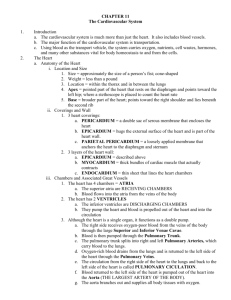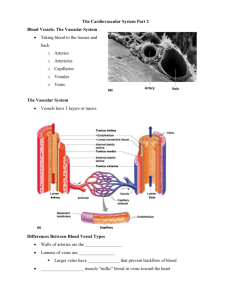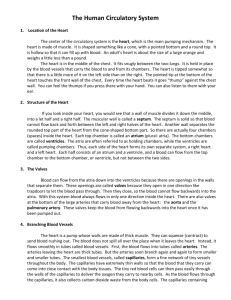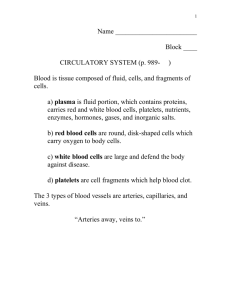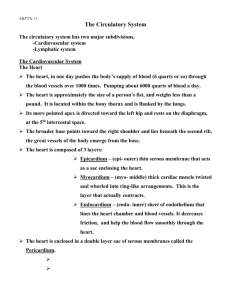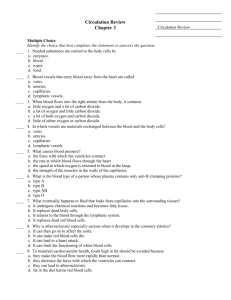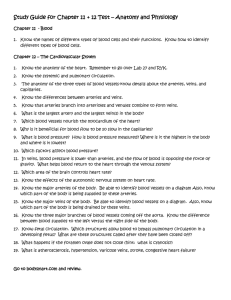Ch. 15 Outline
advertisement
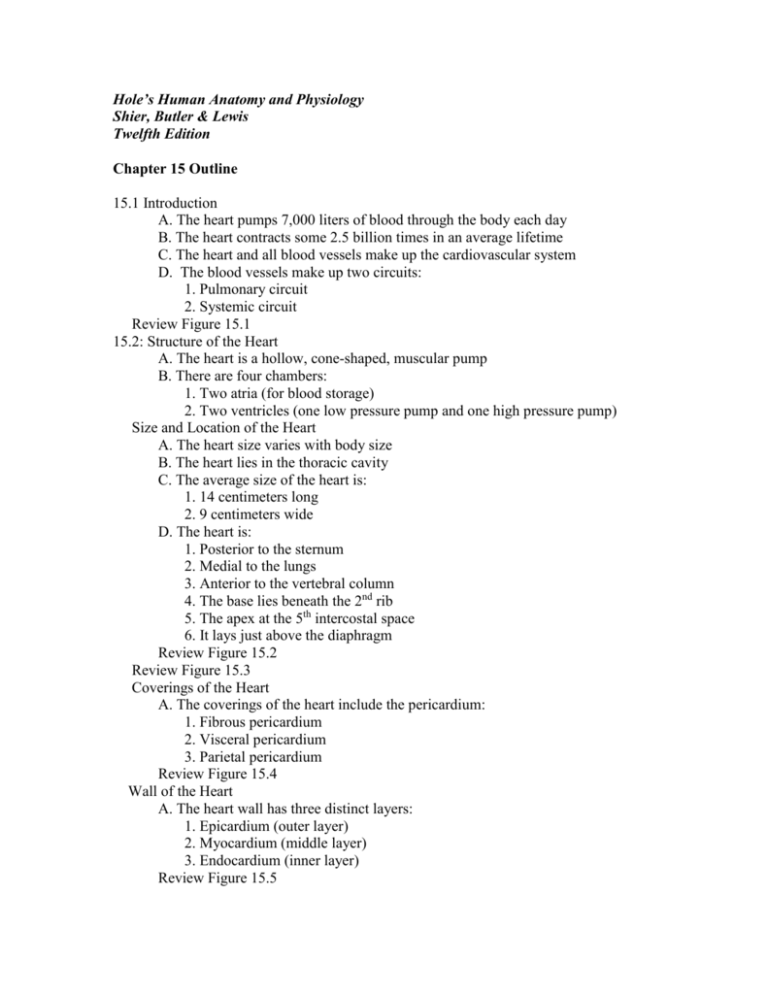
Hole’s Human Anatomy and Physiology Shier, Butler & Lewis Twelfth Edition Chapter 15 Outline 15.1 Introduction A. The heart pumps 7,000 liters of blood through the body each day B. The heart contracts some 2.5 billion times in an average lifetime C. The heart and all blood vessels make up the cardiovascular system D. The blood vessels make up two circuits: 1. Pulmonary circuit 2. Systemic circuit Review Figure 15.1 15.2: Structure of the Heart A. The heart is a hollow, cone-shaped, muscular pump B. There are four chambers: 1. Two atria (for blood storage) 2. Two ventricles (one low pressure pump and one high pressure pump) Size and Location of the Heart A. The heart size varies with body size B. The heart lies in the thoracic cavity C. The average size of the heart is: 1. 14 centimeters long 2. 9 centimeters wide D. The heart is: 1. Posterior to the sternum 2. Medial to the lungs 3. Anterior to the vertebral column 4. The base lies beneath the 2nd rib 5. The apex at the 5th intercostal space 6. It lays just above the diaphragm Review Figure 15.2 Review Figure 15.3 Coverings of the Heart A. The coverings of the heart include the pericardium: 1. Fibrous pericardium 2. Visceral pericardium 3. Parietal pericardium Review Figure 15.4 Wall of the Heart A. The heart wall has three distinct layers: 1. Epicardium (outer layer) 2. Myocardium (middle layer) 3. Endocardium (inner layer) Review Figure 15.5 Review Table 15.1 Heart Chambers and Valves A. The heart is divided into four chambers: 1. Right atrium: a. Receives blood from the: 1). Inferior vena cava 2). Superior vena cava 3). Coronary sinus 2. Right ventricle a. Receives blood from the right atrium 3. Left atrium a. Receives blood from the pulmonary veins 4. Left ventricle a. Receives blood from the left atrium Review Table 15.2 Review Figure 15.6 Review Figures 15.7 and 15.8 Skeleton of the Heart A. The fibrous rings, together with other masses of dense connective tissue in the portion of the septum between the ventricles (interventricular septum), constitute the skeleton of the heart Review Figure 15.9 Path of Blood Through the Heart Review Figure 15.10 Review Figure 15.11 Blood Supply to the Heart A. The left and right coronary arteries supply blood to the tissues of the heart Review Figure 15.15 Review Figures 15.12, 15.13, and 15.14 15.3: Heart Actions A. The heart chambers function in coordinated fashion B. Heart actions are regulated so that atria contract (atrial systole) while ventricles relax (ventricular diastole); followed by ventricles contract (ventricular systole) while atria relax (atrial diastole) Review Figure 15.16 Cardiac Cycle A. During a cardiac cycle, the pressure in the heart chambers rise and falls B. In atrial systole and ventricular diastole: 1. Blood flows passively into the ventricles 2. The remaining 30% of blood is pushed into the ventricles 3. The A-V valves open and the semilunar valves close 4. The ventricles relax 5. This causes an increase in ventricular pressure C. In ventricular systole and atrial diastole: 1. The A-V valves close 2. The chordae tendinae prevent the cusps of the valves from bulging too far into the atria 3. The atria relax 4. The blood flows into atria 5. The ventricular pressure increases and opens the semilunar valves 6. The blood flows into pulmonary trunk and aorta Animation: The Cardiac Cycle Animation: Mechanical Events of the Cardiac Cycle Heart Sounds A. A heart beat through a stethoscope sounds like “lubb-dupp” B. The “lubb” 1. The first heart sound 2. It occurs during ventricular systole 3. The A-V valves are closing C. The “dupp” 1. The second heart sound 2. It occurs during ventricular diastole 3. The pulmonary and aortic semilunar valves are closing D. A murmur – abnormal heart sound from the cusps not completely closing Review Figure 15.17 Cardiac Muscle Fibers A. Cardiac muscle fibers form a functional syncytium B. This is a mass of cells that function as a unit C. Two such areas exist in the heart: 1. In the atrial walls called the atrial syncytium 2. In the ventricular walls called the ventricular syncytium Animation: Action Potentials in the Sinoatrial (SA) Node Cardiac Conduction System A. Clumps or strands of specialized cardiac muscle tissue which initiate and distribute impulses throughout the myocardium B. The cardiac conduction system coordinates the events of the cardiac cycle Review Figure 15.19 Review Figures 15.18 and 15.20 Animation: Conducting System of the Heart 15.1 From Science to Technology Electrocardiogram A. An electrocardiogram or ECG is a recording of electrical changes that occur in the myocardium during the cardiac cycle B. It is used to assess the hearts ability to conduct impulses C. The deflections in the normal ECG, or waves, include: 1. P wave – atrial depolarization 2. QRS complex (three waves) – ventricular depolarization 3. T wave – ventricular repolarization Animation: Baroreceptor Reflex Control of Blood Pressure Review Figures 15.21 and 15.23 Review Figure 15.22 Regulation of the Cardiac Cycle A. The SA node controls the heart rate B. There are also sympathetic and parasympathetic fibers that control the heart rate as well C. There are also regulatory reflex centers that influence heart rate D. Additional factors that may influence heart rate include: 1. Physical exercise 2. Body temperature 3. Concentration of various ions including: a. Potassium b. Calcium 4. Parasympathetic impulses decrease heart action 5. Sympathetic impulses increase heart action 6. Cardiac center regulates autonomic impulses to the heart Review Figure 15.24 Animation: Action Potentials in Cardiac Muscle Cells 15.1 Clinical Application 15.4: Blood Vessels A. The blood vessels are organs of the cardiovascular system B. The blood vessels form a closed circuit to and from the heart C. The blood vessels include: 1. Arteries - carry blood away from the ventricles of the heart 2. Arterioles - receive blood from the arteries and carry blood to the capillaries 3. Capillaries - sites of exchange of substances between the blood and the body cells 4. Venules - receive blood from the capillaries 5. Veins - carry blood toward the atria of the heart Review Figure 15.25 15.2 From Science to Technology Arteries and Arterioles A. Arteries: 1. Thick strong wall (three layers or tunics) 2. Endothelial lining 3. Middle layer of smooth muscle and elastic tissue 4. Outer layer of connective tissue 5. Carries blood under relatively high pressure B. Arterioles: 1. Thinner wall than an artery (three layers or tunics) 2. Endothelial lining 3. Middle and outer layers are thinned 4. Some smooth muscle tissue 5. Small amount of connective tissue 6. Helps control blood flow into a capillary Review Figure 15.26 Capillaries A. Capillaries are the smallest diameter blood vessels B. They connect the smallest arteriole and the smallest venule C. They are extensions of the inner lining of arterioles D. The walls are endothelium only E. They are semi-permeable Review Figure 15.27 Review Figure 15.28 Review Figure 15.29 Review Figure 15.30 Venules and Veins A. Venule: 1. Microscopic vessels that continue from the capillaries and merge to form veins 2. Thinner walls than arterioles 3. Less smooth muscle and elastic tissue than arteriole B. Veins: 1. Thinner walls than arteries (three layers or tunics) 2. Middle wall poorly developed 3. Many have flap-like valves 4. Carry blood under relatively low pressure 5. Function as blood reservoirs Review Figures 15.31 and 15.32 Review Table 15.3 15.5: Blood Pressure A. Blood pressure is the force the blood exerts against the inner walls of the blood vessels Arterial Blood Pressure A. Arterial blood pressure: 1. Rises when the ventricles contract 2. Falls when the ventricles relax 3. Systolic pressure is the maximum pressure during ventricular contraction 4. Diastolic pressure is the minimum pressure when the ventricles relax Review Figure 15.33 15.2 Clinical Application Factors That Influence Arterial Blood Pressure Review Figure 15.34 15.3 Clinical Application 15.4 Clinical Application Control of Blood Pressure A. Blood pressure (BP) is determined by cardiac output (CO) and peripheral resistance (PR) according to this relationship: BP = CO x PR B. Maintenance of blood pressure requires regulation of these two factors Review Figure 15.36 Review Figures 15.37 and 15.38 Animation: Arteriolar Resistance and Blood Pressure Venous Blood Flow A. Blood pressure decreases as the blood moves through the arterial system and into the capillary network, so little pressure remains at the venular ends of the capillaries B. Only partly a direct result of heart action C. Dependent on: 1. Skeletal muscle contraction 2. Breathing 3. Venoconstriction Review Figure 15.39 15.5 Clinical Application Central Venous Pressure A. All veins, except those returning to the heart from the lungs, drain into the right atrium B. This is therefore pressure in the right atrium C. Factors that influence it alter flow of blood into the right atrium D. It effects pressure within the peripheral veins E. A weakly beating heart increases central venous pressure F. An increase in central venous pressure causes blood to back up into the peripheral veins G. This can lead to peripheral edema 15.6 Clinical Application 15.6: Paths of Circulation A. Blood vessels can be divided into two major pathways: 1. The pulmonary circuit 2. The systemic circuit (includes coronary circulation) Pulmonary Circuit Review Figure 15.40 Review Figure 15.41 Systemic Circuit A. Composed of vessels that lead from the heart to all body parts (except the lungs) and back to the heart B. Includes the aorta and its branches C. Includes the system of veins that return blood to the right atrium 15.7: Arterial System Review Figure 15.51 Principal Branches of the Aorta Review Table 15.4 Review Figures 15.42 and 15.43 Arteries to the Brain, Head, and Neck Review Figures 15.44, 15.45, and 15.46 Arteries to the Shoulder and Upper Limb Review Figure 15.47 Arteries to the Thoracic and Abdominal Walls Review Figure 15.48 Arteries to the Pelvis and Lower Limb Review Figures 15.49 and 15.50 15.8: Venous System Review Figure 15.58 Characteristics of Venous Pathways A. Vessels of the venous system originate with the merging of capillaries into venules, venules into small veins, and small veins into larger ones B. Unlike arterial pathways, those of the venous system are difficult to follow due to irregular networks and unnamed tributaries Veins from the Brain, Head, and Neck Review Figure 15.52 Veins from the Upper Limb and Shoulder Review Figure 15.53 Veins from the Abdominal and Thoracic Walls Review Figure 15.54 Veins from the Abdominal Viscera Review Figure 15.55 Review Figure 15.56 Veins from the Lower Limb and Pelvis Review Figure 15.57 15.9: Lifespan Changes A. Cholesterol deposition in the blood vessels B. Heart enlargement C. Death of cardiac muscle cells D. Increase in fibrous connective tissue of the heart E. Increase in adipose tissue of the heart F. Increase in blood pressure G. Decrease in resting heart rate 15.7 Clinical Application 15.8 Clinical Application Outcomes to be Assessed 15.1: Introduction Discuss the functions of the organs of the cardiovascular system. 15.2: Structure of the Heart Distinguish between the various coverings of the heart and the layers that compose the wall of the heart. Identify and locate the major parts of the heart and discuss the function of each part. Trace the pathway of the blood through the heart and the vessels of coronary circulation. 15.3: Heart Actions Describe the cardiac cycle and explain how heart sounds are produced. Identify the parts of a normal ECG pattern and discuss the significance of this pattern. Explain control of the cardiac cycle. 15.4: Blood Vessels Compare the structures and functions of the major types of blood vessels. Describe how substances are exchanged between blood in capillaries and the tissue fluid surrounding body cells. 15.5: Blood Pressure Explain how blood pressure is produced and controlled. Describe the mechanisms that aid in returning venous blood to the heart. 15.6: Paths of Circulation Compare the pulmonary and systemic circuits of the cardiovascular system. 15.7-15.8: Arterial System – Venous System Identify and locate the major arteries and veins. 15.9: Lifespan Changes Describe the lifespan changes in the cardiovascular system.

